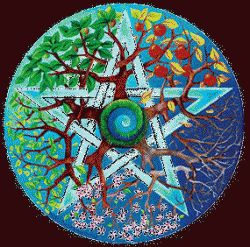Esbats

SABBATS
Each of the Celtic Festivals has an open celebration day. The Sabbat for each Festival is the evening before, when the real meaning of the festival is celebrated by Wiccans and other Pagan groups leaving the day following to celebrate with friends and family.
The Sabbat Rituals: The alternative names are given in brackets
Winter Solstice: (Yule) The rebirth of the Sun God from the womb of the Goddess.
Imbolc: The Quickening of Nature started by the first appearance of new life generated by the God.
Spring Equinox: (Eostara) The young God becomes the Great Stag and mates with the stirring body of the Maiden Goddess.
Beltane: The marriage of the Goddess and God.
Summer Solstice: (Litha) The God is at height of his energy and power.
Lughnasadh: Marks the decline and aging of the God, and his gift of First Harvest.
Autumn Equinox: Second harvest of berries and nuts. The God is very old; the Goddess begins her retreat into the Underworld.
Samhain: Ancestral gathering; the wild hunt comes; the ancient God is wild and searching for lost souls to take with him to the Underworld where he will seek the goddess, to melt in her embrace of death preparing for his rebirth at the Winter solstice.
ESBATS
We also honour the Moon as an entity, whom we see as a representative of the Goddess in all her phases. The moon waxes to Full Moon, then wanes to Dark of the Moon in an approximately 28 day cycle. During the waxing to Full Moon the pull on the tides and our bodies (we are mostly water) increases steadily, and at Full Moon that power is at its greatest, and magic is all around.
Full of waxing Moon magic is for things to be made manifest, for things to come to you and for healing energies to be generated. Waning and Dark Moon magic however is still used in a structured way to get rid of or banishing unwanted things, and for some forms of healing.



